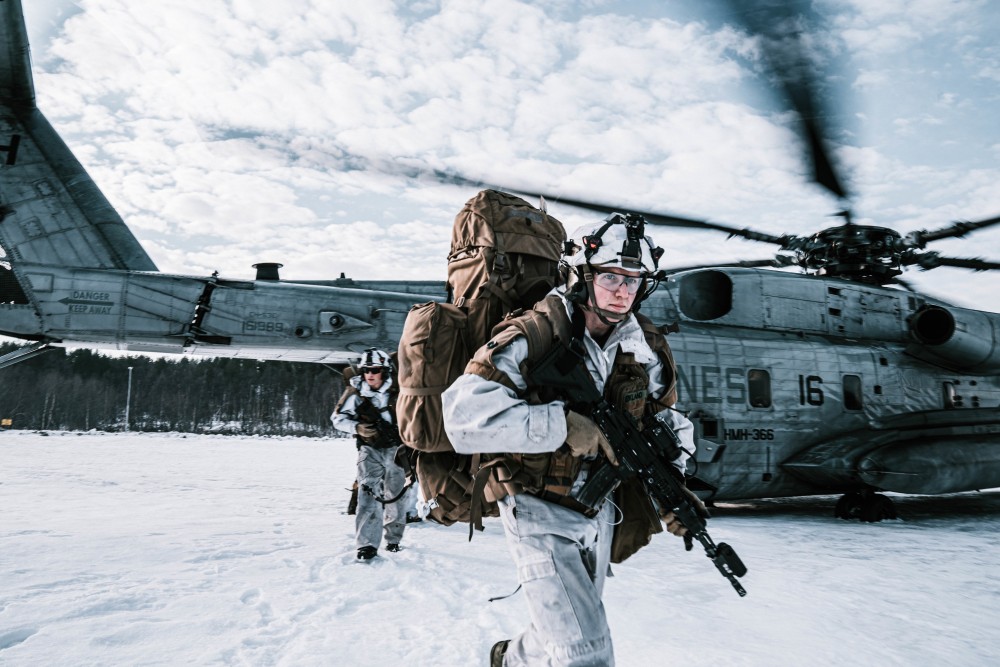
Agile, postured, ready with Allies and partners in the Arctic
ADVERTISEMENT
The U.S. National Strategy for the Arctic Region emphasizes the United States of America’s desire for an Arctic region that is peaceful, stable, prosperous, and cooperative. The Arctic strategy is critical to protecting the U.S. homeland, and relies heavily on coordinating shared approaches with Allies and partners to mitigate risks of unintended escalation. It follows that U.S. European Command’s (USEUCOM) coordination with other U.S. combatant commands, and the broader inter-agency of government, becomes essential to implementing this globally integrated Arctic strategy.
The USEUCOM Combatant Command Campaign Plan addresses this need for integration by underscoring the importance of Allied and partner forces operating effectively across all domains, including in the harsh environments of the Arctic.
With six of the eight Arctic Council member nations residing in the European theater, USEUCOM maintains close, trusting relationships with our Arctic Allies and partners to protect our homelands from threats originating from, in and through the Arctic.
Beyond the complex and compelling operations and exercises the command oversees in the High North, our better understanding of the important roles of indigenous communities, and the long-term effects of climate change, also remain priorities.
Countering Malign Influence
The Arctic region is not only vital geography to protect the American people and our sovereign territory and rights, but it is also of growing interest to our strategic competitors. The Arctic’s growing importance has intensified competition to shape its future as countries pursue new economic interests and prepare for increased activity.
Russia’s war in Ukraine raised geopolitical tensions in the Arctic, as it has globally, creating new risks of unintended conflict and hindering cooperation. Over the last decade, Russia invested significantly in its military presence in the Arctic. It is modernizing its military bases and airfields; deploying new coastal and air defense missile systems and upgraded submarines; and increasing military exercises and training operations with a new combatant command-equivalent for the Arctic.
Russia’s war in Ukraine, however, redoubled North Atlantic Treaty Organization’s (NATO) unity and resolve and spurred efforts to expand NATO resourcing. It has also enhanced unity with our Arctic partners, as evidenced by Finland and Sweden’s pending NATO accession.
ADVERTISEMENT
Russia is also expanding economic infrastructure in the Arctic, developing hydrocarbons, minerals, and fisheries and is attempting to constrain freedom of navigation through its excessive maritime claims and regulations along the Northern Sea Route. Russia’s aggressive militarization and commercialization of the Arctic have increased incidences of toxic waste and spills, leading to further environmental damage.
The People’s Republic of China (PRC) also seeks to increase its influence in the Arctic through an expanded slate of economic, diplomatic, scientific, and military activities. Despite not being an Arctic nation, the PRC has emphasized its intention to play a larger role in shaping regional governance.
Over the last decade, the PRC has doubled its investments there, with a focus on critical mineral extraction; expanded its scientific activities; and used these scientific engagements to conduct dual-use research with intelligence collection or military applications in the Arctic.
Additionally, according to open source reporting, the PRC is expanding its icebreaker fleet and last year sent naval vessels into the High North alongside Russian Navy ships.
While there is much we still don’t know about climate change, it is reasonable to presume that Russian and Chinese activities are not helpful. In a study released last year, scientists estimate that the Arctic is warming four to five times faster than the rest of the world. This phenomenon, known as “Arctic Amplification” is already influencing how we protect our territories, respond to crises, and ensure sovereignty.
No single nation can solve security challenges related to environmental and climate change, but we continue to improve our understanding and problem solving through close collaboration with Allies and partners. USEUCOM, U.S. Northern Command, Alaskan Command, and other commands have incorporated climate-related effects and mitigation investments in our planning.
Despite the challenges to Arctic cooperation stemming from Russian and Chinese malign activity, the United States works to sustain institutions for cooperation, including the Arctic Council. Working closely with new organizations like the Ted Stevens Center for Arctic Security Studies, and established ones like the 30-year-old George C. Marshall European Center for Security Studies, USEUCOM and others seek to manage the security impacts of increasing activity in the region.
Strong and Longstanding Relationships
The United States’ strong defense relationships with Arctic Allies and partners constitute our greatest strategic advantage in the region. Our network of allied relationships and capabilities, including NATO and the North American Aerospace Defense Command (NORAD), strengthens our collective deterrence against strategic challenges.
These relationships go beyond the national level governments, involving provincial, local, and High North indigenous communities, including the six Arctic Indigenous organizations that hold Permanent Participant status in the Arctic Council. These communities have rich heritages and a wealth of experience surviving and thriving in the Arctic that further enhances our capabilities. Partnering with these communities in dialogues, exercises, and training mutually helps refine our strategic planning and execution.
The Arctic Security Forces Roundtable, co-chaired by USEUCOM and the Norwegian Defense Staff, is the longest running military forum focused on the Arctic’s uniquely challenging security dynamics as well as the full range of military capabilities and cooperation required to protect the strategically important region.
America’s bilateral relationships with the Arctic nations are some of the nation’s longest-held and most enduring relationships – militarily, diplomatically, and commercially. Notably, the United States established relations with Denmark in 1801; with Norway and Sweden in 1905; with Finland in 1919; with Canada in 1927; and with Iceland in 1941.
Postured and Ready Forces
USEUCOM and its components frequently conduct Arctic exercises alongside our Allies and partners, honing the ability to rapidly deploy large, combat-credible forces, and improving interoperability. The deployment of U.S. forces to the Arctic is evidence of America’s enduring commitment to Allies and partners, to a whole, free, stable Euro-Atlantic region, and to the sovereignty of the U.S. and the American people.
Conducting a diverse portfolio of year-round exercises, such as Arctic Forge and Nordic Response, America’s fighting forces continually hone their skills alongside NATO Ally and partner nations by operating in the world’s harshest climate and terrain of the High North, improving interoperability between and among Allies.
Arctic Forge 23, which took place this month, is a U.S. Army Europe and Africa led umbrella exercise that leverages the host-nation exercises Defense Exercise North in Finland, and exercise Joint Viking in Norway, to focus on building capabilities, expand collaborative planning, and improve interoperability.
U.S. Marine Corps Forces-Europe, a USEUCOM subordinate command, maintains prepositioned equipment and materiel in Norway – in climate-controlled storage facilities referred to as “The Caves” – that can be quickly drawn to support Arctic exercises and contingency operations.
The United States’ ability to quickly respond and support NATO Allies and partners rests heavily upon the fact that we train and operate together – whether on the ground, in the waters, in cyber and space or in the skies overhead with the Bomber Task Force.
U.S. forces continuously evaluate their capability to receive, stage, move supplies and integrate with other units – American and NATO Ally and partner units alike. This requires a mindset of global integration and will continue to present opportunities for greater collaboration.
To respond to 21st-century security challenges, America’s military forces remain fast, mobile, agile and capable of rapidly surging to locations as challenging and diverse as the High North. Enabled by global integration, we will continue to work alongside our Allies and partners to anticipate and meet head-on the challenges of an ever-changing security environment.
About the Author
Brig Gen Edward Vaughan serves as Deputy Director for Security Cooperation, Global Partnering, and Space Capabilities for USEUCOM. He has two decades experience flying and operating in the Polar Regions, primarily as aircrew in USAF LC-130 ski-planes. He previously commanded the joint military detachment at McMurdo Station, Antarctica, and prior to his current assignment, served as Deputy Commander of the Canadian NORAD region. In 2022, he served as acting co-chair of the Arctic Security Forces Roundtable.
ADVERTISEMENT
The Barents Observer Newsletter
After confirming you're a real person, you can write your email below and we include you to the subscription list.

